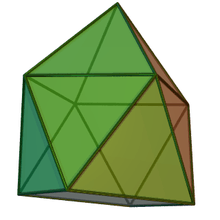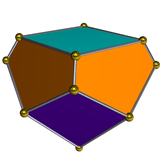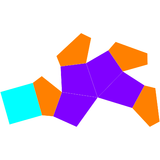Gyroelongated square pyramid
In geometry, the gyroelongated square pyramid is one of the Johnson solids (J10). As its name suggests, it can be constructed by taking a square pyramid and "gyroelongating" it, which in this case involves joining a square antiprism to its base.
| Gyroelongated square pyramid | |
|---|---|
 | |
| Type | Johnson J9 - J10 - J11 |
| Faces | 3*4 triangles 1 square |
| Edges | 20 |
| Vertices | 9 |
| Vertex configuration | 1(34) 4(33.4) 4(35) |
| Symmetry group | C4v, [4], (*44) |
| Rotation group | C4, [4]+, (44) |
| Dual polyhedron | - |
| Properties | convex |
| Net | |
 | |
A Johnson solid is one of 92 strictly convex polyhedra that is composed of regular polygon faces but are not uniform polyhedra (that is, they are not Platonic solids, Archimedean solids, prisms, or antiprisms). They were named by Norman Johnson, who first listed these polyhedra in 1966.[1]
Applications
The Gyroelongated square pyramid represents the capped square antiprismatic molecular geometry:
Dual polyhedron
The dual of the gyroelongated square pyramid has 9 faces: 4 kites, 1 square and 4 pentagonal.
| Dual gyroelongated square pyramid | Net of dual |
|---|---|
 |
 |
gollark: I assume you mean 0.02%.
gollark: That would be very worrying.
gollark: It's a different person each time, actually.
gollark: Do people not talk about "long covid" a lot?
gollark: Well, the UK is moving into the "ignore it and hope it goes away" phase shortly.
See also
External links
- Johnson, Norman W. (1966), "Convex polyhedra with regular faces", Canadian Journal of Mathematics, 18: 169–200, doi:10.4153/cjm-1966-021-8, MR 0185507, Zbl 0132.14603.
This article is issued from Wikipedia. The text is licensed under Creative Commons - Attribution - Sharealike. Additional terms may apply for the media files.
